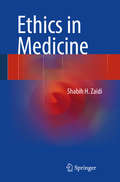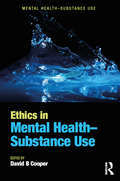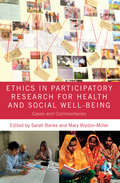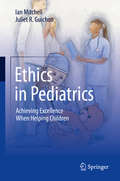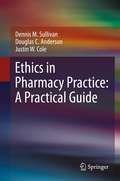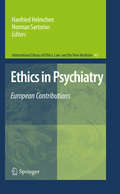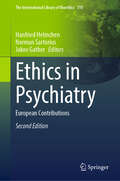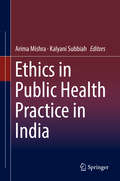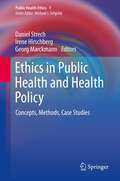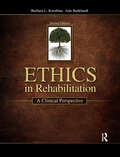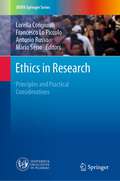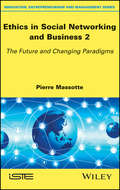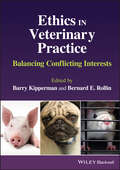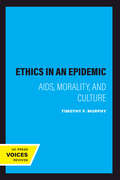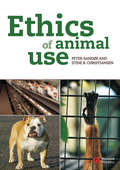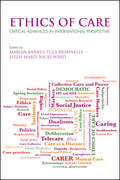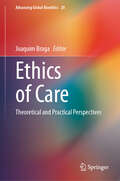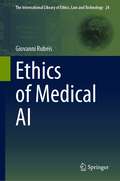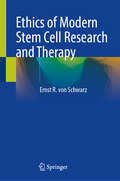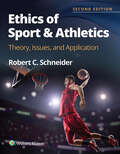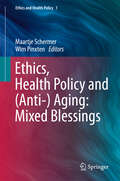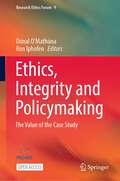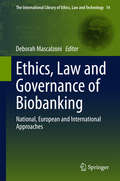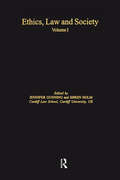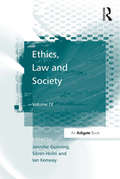- Table View
- List View
Ethics in Medicine
by Shabih H. ZaidiThis book both presents a succinct history of medical ethics and discusses a wide range of important ethical dilemmas in the provision of modern health care. A synopsis is provided of ethics through the ages and the role of ethics in the evolution of medicine. Principles and sources of medical ethics, as well as different religious and secular perspectives, are explained. Ethical concerns in relation to a variety of specific issues are then examined. These issues include, for example, human experimentation, stem cell research, assisted reproductive technologies, termination of pregnancy, rationing of health care, euthanasia, and quality of life issues. The author's many years of practicing medicine in different cultures and countries and his passion for theology works, philosophy, literature, poetry, history, and anthropology have informed and enriched the contents of this stimulating book.
Ethics in Mental Health-Substance Use (Mental Health–Substance Use)
by David B CooperEthics in Mental Health-Substance Use aims to explore the comprehensive concerns and dilemmas occurring from mental health and substance use problems, and to inform, develop, and educate by sharing and pooling knowledge, and enhancing expertise, in this fast developing region of ethics and ethical care and practice. This volume concentrates on ethical concerns, dilemmas, and concepts specifically interrelated, as a collation of problem(s) that directly or indirectly affect the life of the individual and family. Whilst presenting a balanced view of what is ethically best practice today, this title challenges concepts and stimulates debate, exploring all aspects of the development in treatment, intervention and care responses, and the adoption of research-led best practice.
Ethics in Participatory Research for Health and Social Well-Being: Cases and Commentaries
by Mary Brydon-Miller Sarah BanksParticipatory research is well-established as an approach involving people with a direct interest in, or experience of, the issue being studied in carrying out research. However, it raises unique and challenging ethical issues. Traditional concerns with respect for the rights to confidentiality, consent, privacy and protection of ‘research informants’ do not translate easily into participatory research. Boundaries between researchers and those researched are often blurred; research trajectories may be emergent and unpredictable; and major ethical issues revolve around partnership, power, equality and respect for diverse knowledges. The book introduces the key ethical issues in participatory research, drawing on ethical theory and relevant literature before presenting seven substantive chapters, each on a different theme, such as power, ownership, confidentiality and boundaries. The chapters feature an introductory overview of the topic with reference to the literature, followed by four real-life case examples written by participatory researchers and short commentaries on each case. Drawn from around the world (from Denmark to Tanzania), the cases illustrate a range of ethical issues, outlining how they were handled and the reflections and feelings of the contributors. Focusing on developing ethical awareness, confidence and courage to act in ethically challenging situations in everyday research practice, this book is an invaluable resource for all participatory researchers.
Ethics in Pediatrics: Achieving Excellence When Helping Children
by Ian Mitchell Juliet R. GuichonThis book offers easy access to the everyday ethics problems that occur in the medical care of children. It contains practical guidance on how physicians and other healthcare practitioners may manage both straightforward and complex ethics problems. The book provides a readable and comprehensive introduction to ethics issues for beginners and is also extremely valuable to experienced practitioners.This work covers important "classical" ethical issues such as privacy, confidentiality, truth telling, and discusses the elements of the relationships that might exist between parents and healthcare providers. However, the book also provides a resource for new and emerging areas of bioethics. These include issues arising in the new population of children who are beginning to survive the neonatal and infant periods with a multitude of problems – “children with medical complexity". Finally, it also includes a section on the advantages and pitfalls of social media use.
Ethics in Pharmacy Practice: A Practical Guide
by Dennis M. Sullivan Douglas C. Anderson Justin W. ColeThis textbook offers a unique and accessible approach to ethical decision-making for practicing pharmacists and student pharmacists. Unlike other texts, it gives clear guidance based on the fundamental principles of moral philosophy, explaining them in simple language and illustrating them with abundant clinical examples and case studies. The strength of this text is in its emphasis on normative ethics and critical thinking, and that there is truly a best answer in the vast majority of cases, no matter how complex. The authors place high trust in a pharmacist’s moral judgment. This teaches the reader how to think, based on ethical principles, not necessarily what to think. This means navigating between the two extremes of overly theoretical and excessively prescriptive. The cogent framework given in this text uses the language of competing duties, identifying the moral principles at stake that create duties for the pharmacist. This is the balancing act of normative ethics, and of deciding which duties should prevail in a given clinical situation. This work presents a clear-cut pathway for resolving ethical dilemmas encountered by pharmacists, based on foundational principles and critical thinking.Presents a clear-cut pathway for resolving the ethical dilemmas encountered by pharmacists, based on foundational principles and critical thinking.Jon E. Sprague, RPh, PhD, Director of Science and Research for the Ohio Attorney General
Ethics in Psychiatry: European Contributions
by Norman Sartorius Hanfried HelmchenEthics in Psychiatry: (1) presents a comprehensive review of ethical issues arising in psychiatric care and research; (2) relates ethical issues to changes and challenges of society; (3) examines the application of general ethics to specific psychiatric problems and relates these to moral implications of psychiatry practice; (4) deals with recently arising ethical problems; (5) contains contributions of leading European ethicists, philosophers, lawyers, historians and psychiatrists; (6) provides a basis for the exploration of culture-bound influences on morals, manners and customs in the light of ethical principles of global validity.
Ethics in Psychiatry: European Contributions (The International Library of Bioethics #110)
by Norman Sartorius Hanfried Helmchen Jakov GatherThis book presents a comprehensive review of ethical issues arising in psychiatric care and research. Compared to the first edition, ten of the 40 chapters comprising the book are new, dealing with topics that were not covered in the previous edition. A further 28 chapters have been updated by the previous authors or completely rewritten by new authors. Containing contributions by leading European ethicists, philosophers, legal scholars, and psychiatrists, this book presents an excellent resource of information and insights for both psychiatrists and other professionals who wish to develop knowledge, understanding, and awareness about ethical issues arising in their practice, research and public health action. Chapter 6 is available open access under a Creative Commons Attribution 4.0 International License via link.springer.com.
Ethics in Public Health Practice in India
by Arima Mishra Kalyani SubbiahThis edited volume draws on ten original contributions that locate ethics at the centre-stage of public health practice. The essays explicate ethical issues, challenges, deliberations and resolutions covering a broad canvas of public health practice including policies, programmes, research, training and advocacy. The contributors are academics and practitioners in varying roles and long-standing engagement with public health in diverse settings within India. Their expertise in disciplines range from anthropology, sociology, health communications, gender studies, economics, epidemiology, social work and medicine. Their chapters deal with dimensions of ethical dilemmas that can rarely be defined and contained within ethical guidelines and protocols alone. Instead, they throw light on the associated factors, value systems and contexts in which such complexities occur and require response or redressal. This volume aims to articulate the growing awareness among practitioners that public health ethics is not merely an advanced grouping of possible problems and solutions. It hopes to facilitate robust platforms for dialogue and debate on the subject through the lenses of these contributions. The book is conceptualized to reach broader audiences such as public health practitioners and researchers in several roles within Government health systems, NGOs/Grass root organizations/CSR initiatives/advocacy groups; as well as researchers in academic settings and facilitators involved in teaching ethics and imparting training for students and young practitioners of public health.
Ethics in Public Health and Health Policy: Concepts, Methods, Case Studies
by Irene Hirschberg Daniel Strech Georg MarckmannEthical issues associated with public health and health policy--related, for example, to pandemic plans and vaccination policies (c.f. SARS or pandemic influenza), preventive measures like screening (e.g. for breast cancer or dementia) or health information campaigns, social inequalities or health care rationing--are increasing in worldwide importance. Evidence-based information for valid benefit-harm assessment is often rare and hard to get for participants in public health interventions. Program implementation often disregards requirements of fair decision-making processes (like public participation, transparency, etc.). Originating from an international conference (based on a call for abstracts and external review), this volume contains contributions from a group of experts from multiple disciplines and countries. It covers (i) conceptual foundations of public health ethics, (ii) methodological approaches and (iii) normative analyses of specific issues and cases. Bridging theoretical foundations with practical applications, this volume provides a valuable resource for researchers, practitioners and students concerned with public health practice and policy.
Ethics in Rehabilitation: A Clinical Perspective
by Ann Burkhardt Barbara KornblauEthical decision-making is a critical component in the broad spectrum of rehabilitation and health care professions today. Ethics in Rehabilitation: A Clinical Perspective, Second Edition was developed to give health and rehabilitation professionals the knowledge and tools they need to approach and solve the ethical dilemmas that challenge them in everyday practice.Following an introduction to ethical theories and principles, Drs. Kornblau and Burkhardt furnish readers with a brief overview of legal principles that may impact ethical decision making, then examine the relationship between ethical and legal principles that clinicians may encounter. The second section provides readers with an opportunity to apply what they have learned and includes more than 100 ethical dilemmas covering a wide variety of practice-related topics. Further reinforcing the concepts, the final sections consist of ethical dilemma worksheets and a set of additional learning resources to assist in the examination and resolution of ethical dilemmas.Features:• More than 100 sample ethical dilemmas extracted from actual practice experiences • Ethical dilemma worksheets to guide learning and illustrate course of action • Extensive set of appendices including sample laws and regulations • Online access to internet resources of state licensure and related lawsEthics in Rehabilitation: A Clinical Perspective, Second Edition offers readers a practical approach to ethics within a clinical context to allow practitioners, educators, and researchers to raise questions, attempt to answer them, and promote and improve ethical practice in rehabilitation.
Ethics in Research: Principles and Practical Considerations (UNIPA Springer Series)
by Antonio Russo Francesco Lo Piccolo Lorella Congiunti Mario SerioThis book draws a connection between ethics and research across social sciences, philosophy, medical sciences and legal sciences, and demonstrates that any research activity needs to be conducted by means of rules deriving from the field of ethics. Although having a common core, such rules assume different characteristics depending on the branch of science, as the contributions on philosophy, medicine, dentistry, law, biotechnology, robotics and architecture highlight. It also investigates the more complex ethical concerns and places them in a larger, technological context. Starting with an introduction to common-sense ethical principles, the contributions then guide the reader, helping them develop and understand a comprehensive knowledge on the field. Notably, it appeared interesting to analyze recent events related to the arrival of the Sars-CoV-2 pandemic in light of ethical principles, highlighting in what terms their applicability can still be confirmed. Moreover, the book makes these topics accessible to a non-expert audience, while also offering alternative reading pathways to inspire more specialized readers.
Ethics in Social Networking and Business 2: The Future and Changing Paradigms
by Pierre MassotteThis book, the second of two volumes dedicated to ethics in social networking and business, presents the future and changing paradigms related to ethics, and morality in our interconnected society. This volume analyzes advanced topics, including new technologies, transhumanism and uberization, to provide a more complex, shared and collective environment into why business ethics is essential for managing risks and uncertainties. The Ethics in Social Networking and Business series is the result of a cross-integration of real experiences (from IBM, society and the Rotary Club), transdisciplinary works in decision making, and advances at the boundaries of several scientific fields.
Ethics in Veterinary Practice: Balancing Conflicting Interests
by Bernard E. Rollin Barry KippermanEthics IN Veterinary Practice An incisive examination of relevant and contemporary ethical issues facing veterinary practitioners, students, instructors, and animal researchers In Ethics in Veterinary Practice: Balancing Conflicting Interests, a team of distinguished scholars delivers a foundational exploration of animal ethics and a guide to examining contemporary issues and dilemmas that arise regularly in veterinary practice. The book offers comprehensive, quickly accessible, and up-to-date information on veterinary ethics with content devoted to unique issues by practice type. The authors offer a primary resource for veterinary ethics useful for veterinarians, faculty, instructors, senior undergraduates, and veterinary students that focuses on recognizing and addressing real-life ethical dilemmas and relevant philosophical discussions about the moral status of animals, animal rights, and interests. Ethics in Veterinary Practice presents material on integrative medicine, animal pain, moral stress, and the future of veterinary ethics. Readers will also find: A thorough introduction to a theoretical basis for veterinary ethics, including discussions of animal welfare, ethical theories, and legal issues Comprehensive explorations of clinical veterinary ethics, including discussions of veterinary advocacy, ethical dilemmas, professionalism, economic issues, and medical errors Practical discussions of ethical concerns by practice type, including companion animals, equines, and animals used for food In-depth examination of emerging ethical concerns including animal use in veterinary education and animal maltreatment Perfect for practicing veterinarians, veterinary students, and veterinary technicians and nurses, Ethics in Veterinary Practice: Balancing Conflicting Interests will also earn a place in the libraries of instructors teaching veterinary ethics, as well as biomedical and animal ethicists.
Ethics in an Epidemic: AIDS, Morality, and Culture
by Timothy F. MurphyAIDS strikes most heavily at those already marginalized by conventional society. With no immediate prospect of vaccination or cure, how can liberty, dignity, and reasoned hope be preserved in the shadow of an epidemic? In this humane and graceful book, philosopher Timothy Murphy offers insight into our attempts—popular and academic, American and non-American, scientific and political—to make moral sense of pain.Murphy addresses the complex moral questions raised by AIDS for health-care workers, politicians, policy makers, and even people with AIDS themselves. He ranges widely, analyzing contrasting visions of the origin and the future of the epidemic, the moral and political functions of obituaries, the uncertain value of celebrity involvement in anti-AIDS education, the functional uses of AIDS in the discourse of presidential campaigns, the exclusionary function of HIV testing for immigrants, the priority given to AIDS on the national health agenda, and the hypnotic publicity given to "innocent" victims.Murphy's discussions of the many social and political confusions about AIDS are unified by his attempt to articulate the moral assumptions framing our interpretations of the epidemic. By understanding those assumptions, we will be in a better position to resist self-serving and invidious moralizing, reckless political response, and social censure of the sick and the dying.
Ethics of Animal Use
by Peter Sandøe Stine B. ChristiansenAn interesting and accessible introduction to ethical issues raised by various forms of human use of animals. This textbook avoids moral lecturing and presents a range of ethical viewpoints without defending or applying any specific stance. Readers are encouraged and provoked to reflect for themselves, and to sharpen their own points of view regarding the ethical limits on our use of animals. They will also gain further understanding of the views held by other people. Early chapters of this interdisciplinary book cover changes over time in our view of animals, the principles of animal ethics, and different views of what counts as a good animal life. Later chapters apply the conceptual tools to specific issues including: food animal production, advanced veterinary treatment of pets, control of infectious diseases, wildlife management, as well as the use of animals in research. Specifically designed for students of veterinary medicine, animal science, welfare and behaviour, and veterinary nursing. Also of interest to those wanting to combine an up-to-date, science-based account of animal issues with clear-headed moral reflection. "The book covers an impressive range of topics with accuracy and fairness. Despite its ambitious scope, the authors have achieved remarkable unity in the book, and have produced a book that is easy and pleasant to read. Their work will surely provide a major tool for rationalizing the debate about the ethics of animal use, and I commend them for their invaluable contribution." From the Foreword by Professor Bernard Rollin, Colorado State University.
Ethics of Care: Critical Advances in International Perspective
by Marian Barnes, Tula Brannelly, Lizzie Ward and Nicki WardOver the last 20 years there has been a flourishing of work on feminist care ethics. This collection makes a unique contribution to this body of work. The international contributors demonstrate the significance of care ethics as a transformative way of thinking across diverse geographical, policy and interpersonal contexts. From Tronto’s analysis of global responsibilities, to Fudge Schormans’ re-imagining of care from the perspective of people with learning disabilities, chapters highlight the necessity of thinking about the ethics of care to achieve justice and well-being within policies and practice. This book will be essential reading for all those seeking such outcomes.
Ethics of Care: Theoretical and Practical Perspectives (Advancing Global Bioethics #20)
by Joaquim BragaThis book offers a set of reflections on the ethics of care in full articulation with some of the most pressing issues of our time. Several themes are analyzed, such as medical care, self-care, justice, economics, politics, and technology. All of them, however, are permeated and united by a common philosophical purpose, namely: an ethics of care not only allows the conception of behavioral relationships and human values but also puts into play the theoretical foundations of ethics itself. It is in this sense that the ethics of care proposed in this volume can be considered metaethics. Since they present multidisciplinary contents and concepts, the chapters of this volume are relevant theoretical tools for researchers, professors, and students, as well as specialized caregivers, who want to deepen the new theoretical and practical implications of care in contemporary society.
Ethics of Medical AI (The International Library of Ethics, Law and Technology #24)
by Giovanni RubeisThis is the first book to provide a coherent overview over the ethical implications of AI-related technologies in medicine. It explores how these technologies transform practices, relationships, and environments in the clinical field. It provides an introduction into ethical issues such as data security and privacy protection, bias and algorithmic fairness, trust and transparency, challenges to the doctor-patient relationship, and new perspectives for informed consent. The book focuses on the transformative impact that technology is having on medicine, and discusses several strategies for dealing with the resulting challenges. It also introduces innovative methods of ethics research for addressing existing desiderata and future challenges. This book is written to inform health care professionals, policy-makers, and researchers in medicine, health sciences, nursing science, social sciences, and ethics, but may also function as a primary textbook for graduate as wellas undergraduate university courses.
Ethics of Modern Stem Cell Research and Therapy
by Ernst R. von SchwarzThis book provides an authoritative and comprehensive overview on the ethical issues surrounding the most promising and most controversially discussed topic in modern biotechnology and medicine, stem cell therapy. It is written by a scientist who has been involved in the basic research of stem cell therapy for over 20 years and was part of the initial experimental studies demonstrating benefits and damage repair using stem cells, and who also is a clinical cardiologist involved in the clinical studies of stem cell therapy in patients with mainly cardiovascular and neurodegenerative diseases from its early stage until now. The book starts with a brief overview of the history of stem cell research, the administrative and regulatory aspects including the federal governmental changes with every political administration over the last 20 years, and the stand of the FDA on research and therapy. It also discusses the issues of medical tourism, patient funded studies, false marketing claims, and the ethical and religious aspects of stem cell research, anti aging research, and immortality research including the Roman Catholic Churches view on embryonic stem cells. Ethics of Modern Stem Cell Research and Therapy will be a valuable resource for clinicians, physicians, and researchers who are looking to either conduct or use stem cell therapies. It offers a one-stop guide to the current regulations of the FDA as well as the potential that stem cell therapies have on many degenerative diseases.
Ethics of Sport and Athletics: Theory, Issues, and Application
by Robert C. SchneiderTimely, accessible, and focused on practical application, Ethics of Sport & Athletics: Theory, Issues, and Applications, Second Edition, details the theories and mechanics of moral reasoning, ethical and unethical behavior in sport, and the development of moral education through sport. This well-organized, case-based approach to sport-related dilemmas teaches readers how to successfully apply moral reasoning skills in good decision making to ensure confidence in sports management. Extensively updated with real-world examples drawn from the latest sports headlines, this Second Edition is designed to help readers grapple with the many complicated ethical challenges they’ll encounter in today’s sports professions, including performance enhancement, violence in sports, and racial and gender discrimination. An expanded emphasis on applying knowledge and concepts in sport management further equips readers to confront specific scenarios, ultimately improving the overall moral integrity of sport without diminishing its competitive element.
Ethics, Health Policy and (Anti-) Aging: Mixed Blessings
by Wim Pinxten Maartje SchermerThis volume focuses on the ethical and philosophical issues that arise in an aging society, and the implications of these issues for healthcare and social policy. After a brief overview of biomedicine's changing approach of ageing and longevity and of the new expectations that these changes generate, various ethical, social, and policy issues that surround aging and longevity are discussed. First, the images and social meanings of aging and old age in our society are explored, including their normative dimensions and implications for policy. Next, ethical issues in the care for frail elderly are discussed, as well as notion of good care and end-of-life decisions. Finally, the ethical and social implications of emerging possibilities for anti-aging and lifespan extension are considered. The book concludes with an overview of the relevance of the issues discussed for policy making on professional, national and international levels.
Ethics, Integrity and Policymaking: The Value of the Case Study (Research Ethics Forum #9)
by Ron Iphofen Dónal O'MathúnaThis Open Access book provides illustrative case studies that explore various research and innovation topics that raise challenges requiring ethical reflection and careful policymaking responses. The cases highlight diverse ethical challenges and provide lessons for the various options available for policymaking. Cases are drawn from many fields, including artificial intelligence, space science, energy, data protection, professional research practice and pandemic planning. Case studies are particularly helpful with ethical issues to provide crucial context. This book reflects the ambiguity of ethical dilemmas in contemporary policymaking. Analyses reflect current debates where consensus has not yet been achieved. These cases illustrate key points made throughout the PRO-RES EU-funded project from which they arise: that ethical judgement is a fluid enterprise, where values, principles and standards must constantly adjust to new situations, new events and new research developments. This book is an indispensable aid to policymaking that addresses, and/or uses evidence from, novel research developments.
Ethics, Law and Governance of Biobanking
by Deborah MascalzoniBiobank research and genomic information are changing the way we look at health and medicine. Genomics challenges our values and has always been controversial and difficult to regulate. In the future lies the promise of tailored medical treatments and pharmacogenomics but the borders between medical research and clinical practice are becoming blurred. We see sequencing platforms for research that can have diagnostic value for patients. Clinical applications and research have been kept separate, but the blurring lines challenges existing regulations and ethical frameworks. Then how do we regulate it? This book contains an overview of the existing regulatory landscape for biobank research in the Western world and some critical chapters to show how regulations and ethical frameworks are developed and work. How should international sharing work? How design an ethical informed consent? An underlying critique: the regulatory systems are becoming increasingly complex and opaque. The international community is building systems that should respond to that. According to the authors in fact, it is time to turn the ship around. Biobank researchers have a moral responsibility to look at and assess their work in relation to the bigger picture: the shared norms and values of current society. Research ethics shouldn't only be a matter of bioethicists writing guidelines that professionals have to follow. Ethics should be practiced through discourse and regulatory frameworks need to be part of that public discourse. Ethics review should be then not merely application of bureaucracy and a burden for researchers but an arena where researchers discuss their projects, receive advice and practice their ethics skills.
Ethics, Law and Society: Volume I
by Søren HolmThis key collection brings together a selection of papers commissioned and published by the Cardiff Centre for Ethics, Law & Society. It incorporates contributions from a group of international experts along with a selection of short opinion pieces written in response to specific ethical issues. The collection addresses issues arising in biomedical and medical ethics ranging from assisted reproductive technologies to the role of clinical ethics committees. It examines broader societal issues with particular emphasis on sustainability and the environment and also focuses on issues of human rights in current global contexts. The contributors collect responses to issues arising from high profile cases such as the legitimacy of war in Iraq to physician-related suicide. The volume will provide a valuable resource for practitioners and academics with an interest in ethics across a range of disciplines.
Ethics, Law and Society: Volume IV
by Søren Holm Jennifer Gunning Ian KenwayThis key collection brings together a selection of papers commissioned and published by the Cardiff Centre for Ethics, Law & Society. It incorporates contributions from a group of international experts along with a selection of short opinion pieces written in response to specific ethical issues. The collection addresses issues arising in biomedical and medical ethics ranging from assisted reproductive technologies to the role of clinical ethics committees. It examines broader societal issues with particular emphasis on sustainability and the environment and also focuses on issues of human rights in current global contexts. The contributors collect responses to issues arising from high profile cases such as the legitimacy of war in Iraq to physician-related suicide. The volume will provide a valuable resource for practitioners and academics with an interest in ethics across a range of disciplines.
